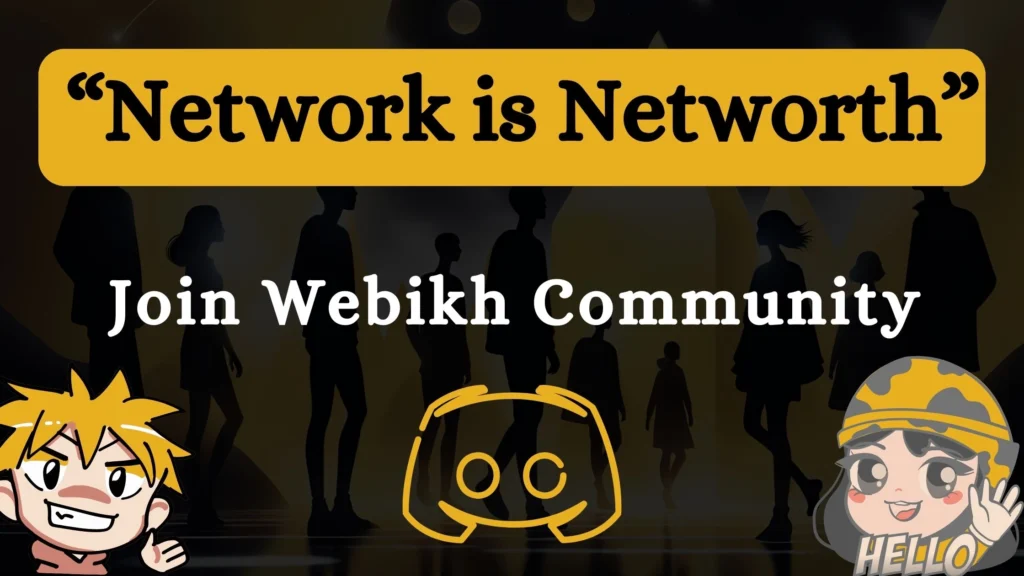What is Fashion’s future With Blockchain and AI in 2024?
How the glamour world be changed in web3?
How does the future of Fashion industry will look like with blockchain?
Can technologies like Metaverse, Artificial Intelligence, Cryptocurrency and NFTs be used in Fashion?
You must be having these questions right?
Fashion, it’s not just about clothing anymore. It’s about self-expression, innovation, and now, thanks to Web3 technologies, it’s about revolutionizing the way we dress and experience fashion.
Let’s dive deeper in the world of web3 and see what it offers for your closet ?
Let’s start with the problems the Fashion sector faces and how it can be tackled ?
Subscribe to Webikh Newsletter
The Only AI and Web3 Focused Newsletter
Subscribe & Download Freebies !
The Problem: Fashion Faces Challenges
Before we unveil the stylish solutions, let’s take a closer look at the challenges plaguing the fashion industry.
🛒 Fast Fashion Conundrum: Fast fashion has been the industry’s go-to model for decades. This means cheap clothes produced rapidly, but it also leads to massive overproduction and excessive waste.
🌏 Sustainability Struggles: As climate change takes center stage, the fashion industry faces increasing pressure to reduce its carbon footprint. From water usage to harmful dyes, the environment often pays the price for fashion.
💼 Counterfeiting Concerns: Knock-offs and counterfeit products cost the global fashion industry billions each year. Authenticity and transparency are more critical than ever.
💔 Exclusivity vs. Accessibility: Luxury brands thrive on exclusivity, but Web3 aims to make fashion more accessible to everyone. Finding the balance is a challenge.
Now, let’s explore how Web3 is sewing solutions into these problems. 👚🌍
The Solution: Web3 Fashion Revolution
👗 NFT Fashion:
Non-fungible tokens (NFTs) are changing the way we view fashion. NFT fashion items, like digital dresses and sneakers, can be bought, sold, and owned as unique digital assets.
Imagine having a one-of-a-kind digital outfit that no one else in the world has! NFT fashion is not just about looking good; it’s about owning a piece of digital art
.
🤖 AI Fashion Design:
Artificial intelligence is playing a crucial role in the fashion design process. AI algorithms can analyze vast amounts of data to predict fashion trends, helping designers create collections that consumers are more likely to love.
This not only reduces waste but also ensures that fashion houses produce what people actually want to wear.
🌟 Virtual Fashion Shows:
The Metaverse is the new runway. Virtual fashion shows are becoming a sensation. Designers are showcasing their latest collections in digital spaces, where attendees can watch from the comfort of their homes.
Plus, you can try on these digital outfits for your virtual self, adding a whole new layer of interactivity to fashion events.
🌿 Sustainable Fashion:
Blockchain technology enables fashion brands to prove the authenticity and sustainability of their products.
By tracing the entire supply chain on a blockchain, consumers can know where their clothes come from, whether they were made ethically, and what materials were used.
This transparency is a game-changer for conscious consumers.
Now that we’ve got our fashion solutions laid out on the runway, let’s dive deeper into how each of these stylish innovations works. 👠🤖
How It Will Work: Unpacking the Fashion Revolution
👗 NFT Fashion:
NFT fashion items are more than just pictures on the internet. They are unique digital assets that use blockchain technology to prove ownership. When you buy an NFT fashion item, you receive a digital certificate of authenticity that is stored on the blockchain. This certificate verifies that you are the true owner of the item. You can display your NFT fashion in virtual worlds, social media, or wherever you choose.
🤖 AI Fashion Design:
AI in fashion design begins with data. AI algorithms sift through massive datasets, including social media trends, runway shows, and consumer preferences. They identify patterns and predict what styles are likely to be popular in the future. Designers use these insights to create collections that resonate with consumers. This data-driven approach minimizes the risk of producing unwanted fashion items.
🌟 Virtual Fashion Shows:
Virtual fashion shows take place in the Metaverse, a digital universe where people can interact with each other and digital objects. Designers create digital avatars that wear their collections. Attendees, represented by their avatars, can watch the show from their devices. What’s remarkable is that these avatars can try on the digital outfits and even purchase the NFT versions of the clothes they see on the runway.
🌿 Sustainable Fashion:
Blockchain technology ensures transparency and traceability in the fashion supply chain. Each step of a garment’s journey, from raw materials to manufacturing and distribution, is recorded on an immutable blockchain. Consumers can scan a QR code on a clothing tag and access all the information about the product’s origins. This transparency allows brands to prove their commitment to sustainable and ethical practices.
The fashion world is evolving into a digital and sustainable realm, where creativity, data, and technology blend to create a more personalized and responsible industry.
Now that we’ve seen how it works, let’s put on our fashionable shades and explore the impact these changes will have on the world of fashion. 🕶️💃
The Impact: How Web3 is Shaping the Future of Fashion
🌐 Global Accessibility: With NFT fashion and virtual shows, fashion becomes accessible to anyone with an internet connection. Geographical boundaries no longer limit your ability to engage with high fashion. Fashion enthusiasts from all corners of the world can now participate in the latest trends and support their favorite designers.
📈 Economic Empowerment: NFT fashion opens up new opportunities for fashion designers. Emerging talents can gain recognition and monetize their creations directly through NFT sales, bypassing traditional gatekeepers. This democratization of the fashion industry could foster a wave of innovation and diversity in design.
🌱 Sustainability: Blockchain’s transparency in the supply chain can hold brands accountable for their sustainability claims. Shoppers can make more informed choices by selecting brands that align with their values. This shift toward conscious consumerism puts pressure on the industry to adopt eco-friendly practices.
🎨 Unlimited Creativity: Virtual fashion shows and digital clothing open the doors to limitless creativity. Designers are not restricted by the physical constraints of fabric or manufacturing. They can experiment with avant-garde designs that may not be feasible in the physical world, pushing the boundaries of fashion.
🧐 Challenges and Risks: While Web3 in fashion brings exciting possibilities, it’s not without challenges. Protecting intellectual property, ensuring secure NFT transactions, and addressing environmental concerns related to blockchain are important issues that need attention.
💼 Job Evolution: The fashion industry’s workforce may evolve with the integration of AI. While AI can assist designers in various tasks, it also raises questions about the future of certain job roles. Designers may need to adapt and learn how to collaborate with AI systems effectively.
The impact of Web3 in fashion extends far beyond what we can currently foresee. It’s a fusion of art, technology, and sustainability that’s redefining the way we express ourselves through clothing. Now, let’s explore the myriad opportunities and possibilities this revolution offers. 🌟👠👕
🚀 Opportunities and Possibilities: What Lies Ahead in Web3 Fashion
Digital Ownership Culture: As NFT fashion gains momentum, it could lead to a culture of digital ownership where people collect and trade digital clothing items just as they do physical ones. This trend could birth new markets, communities, and even fashion museums in the Metaverse.
Personalization on Steroids: AI-driven fashion design takes personalization to a whole new level. Imagine a virtual wardrobe that’s curated just for you, with designs generated based on your preferences, body shape, and even mood. The possibilities for personalized fashion are endless.
Virtual Fashion for Avatars: Metaverse inhabitants will require fashionable attire for their digital personas. Designers will cater to this demand, creating a market for virtual fashion items that are as diverse and stylish as physical clothing.
Fashion as an Experience: Virtual fashion shows in the Metaverse are immersive experiences. Brands can use these shows not just to display their collections but to transport viewers to imaginative worlds that tell stories through fashion. Attendees become active participants in the narrative.
Sustainable Revolution: Blockchain’s transparency can revolutionize sustainability in fashion. Brands that commit to ethical and eco-friendly practices can build trust with consumers who can verify the authenticity of such claims on the blockchain.
🛑 Risks and Challenges: Navigating the Web3 Fashion Landscape
Counterfeiting: Just as in the physical world, the digital fashion industry may face challenges related to counterfeiting. Ensuring the authenticity of NFT fashion items and protecting designers’ intellectual property will be crucial.
Environmental Concerns: Blockchain, while transparent, consumes energy. Fashion brands and blockchain developers will need to explore eco-friendly solutions to mitigate the environmental impact of NFT fashion.
Digital Fatigue: An overabundance of virtual fashion and Metaverse events could lead to digital fatigue. People might seek more meaningful offline experiences, causing shifts in consumer behavior.
AI Ethics: As AI becomes more involved in fashion design, questions of ethics and AI’s influence on beauty standards may emerge. It’s essential to use AI responsibly and inclusively.
Accessibility: While Web3 fashion opens doors, it may also create new barriers, particularly for those who lack access to the internet or advanced technologies. Ensuring inclusivity remains a challenge.
MUST READ :
What is Art & Entertainment’s future With Blockchain and AI?
What is Gaming Sector’s future With Blockchain and AI?
What is Sports’s future With Blockchain, AI and Metaverse?
Conclusion
In conclusion, Web3 is revolutionizing the fashion industry by blurring the lines between the physical and virtual worlds. NFT fashion, AI-driven design, and Metaverse fashion shows are rewriting the rules of what fashion means.
The impact is profound, offering global accessibility, economic empowerment, sustainability, and endless creative possibilities.
However, this transformation also brings challenges related to authenticity, environmental responsibility, and ethical AI use.
The fashion industry is on the cusp of a new era, and how it navigates these challenges will determine its future. 👗🌐✨

FAQ : AI & Blockchain for Fashion Industry
AI won’t take over the fashion industry but will significantly impact it by optimizing design, supply chain, personalization, and customer experience.
Blockchain in the luxury industry ensures product authenticity and traceability. It provides a tamper-proof record of a luxury item’s journey from creation to the consumer, enhancing trust and reducing counterfeiting.








I don’t think the title of your article matches the content lol. Just kidding, mainly because I had some doubts after reading the article.
Can you be more specific about the content of your article? After reading it, I still have some doubts. Hope you can help me.